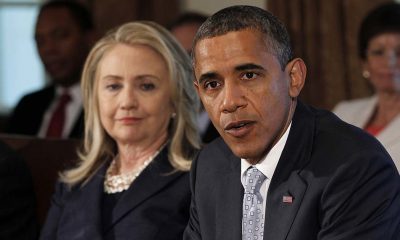World
Indian-Americans lose young scientist title; 5 in final

Washington: Indian-Americans failed to win the 2015 Discovery Education 3M Young Scientist Challenge even as five of them made it to the final ten in the competition to develop scientific plans to solve everyday problems.
The top prize of $25,000 and an “adventure trip” went to Hannah Herbst, 14, a Grade 8 student from of Boca Raton, Florida, at the finals Tuesday in St. Paul.Discovery Education 3M Young Scientist ChallengeDiscovery Education 3M Young Scientist Challenge
She developed an Ocean Energy Probe that aims to provide a stable power source and fresh water to developing countries around the globe by using untapped energy from ocean currents.
Last year 14-year-old Sahil Doshi, an Indian-American ninth grader from Pittsburgh, Pennsylvania was named America’s top young scientist for his innovative, eco-friendly battery design.
Among the five Indian-American finalists this year, Raghav Ganesh, 13, a 7th grader from San Jose, California has invented a device that predicts and prevents Autistic Meltdowns to help those with Autistic Spectrum Disorder and their caregivers.
Monitoring physiological and environmental factors that can cause and trigger stress, Raghav’s wireless and wearable machine alerts the wearer and caregiver when any stressors rise above a certain threshold.
His invention allows care to be tailored to individuals’ needs by recording all sensory data and therapeutic responses. Raghav hopes his invention can help many people in daily situations, catering to the Autistic population and their caregivers.
With a goal of preventing distractions while trying to concentrate, Amulya Garimella, 11, a Grade 6 student from Pittsburgh, Pennsylvania, has invented a distraction monitoring system that alerts the user of distraction by measuring EEG brainwaves.
When users get distracted, they will receive an alert reminding them to concentrate and get back to work. Amulya hopes that being distracted while doing homework or working will be a thing of the past!
Iris Gupta, 12, a sixth grader from North Potomac, Maryland, has invented a device to stop allergies at the source.
She believes that by inhaling or injecting nanoparticles, allergens’ ability to attach to antibodies present in one’s body would be blocked as they entered one’s systems.
Her invention aims to give people suffering from allergies some much needed relief by testing to find the correct amount of nanoparticles optimal for blocking allergens.
Krishna Reddy, 13, Grade 7, from Wichita Falls, Texas, has invented a device that finds other substances that a breathalyzer for alcohol consumption cannot detect.
Krishna created a pupillary reflex computer programme and apparatus that measures pupil dilation.
Many drugs influence the uncontrollable movement of pupil dilation, and by detecting drugs through dilation, Krishna hopes many more preventable accidents can be stopped.
Sanjana V. Shah, 13, a Grade 8 student from Cupertino, California, has created a programme to detect where cities may need more drains and where they may need to increase current drain pipe sizes to prepare for heavy rainfalls.
By using pipe network analysis modelled after city drain pipe maps, Sanjana can simulate heavy rainfall to see where possible flooding may occur.
World
Lockdowns in China Force Urban Communities to Defy Censorship and Vent Frustration Online

Shanghai’s rich middle class is leading a wave of online dissent over the strict and prolonged lockdowns imposed in various parts of the country. Chinese internet censorship is struggling as patience is wearing thin in many urban centers, coming up with creative forms of online protests.
Social Media Posts Revealing Lockdown Tension in Shanghai
Drawn-out lockdowns are nothing new in China as authorities insist with the nation’s zero-Covid policy since the start of the pandemic. Currently over This time around, however, metropolitan areas like Shanghai are increasingly difficult to keep quiet, given that its more than 25 million residents have seen weeks of total isolation along with food shortages and many other service interruptions.
Dozens of towns and reportedly over 300 million Chinese citizens have been affected by lockdowns of different severity. As expected, urban netizens have been most outspoken over their difficulties by finding creative ways to get around state censorship and bans placed on topics, news comments and spontaneous campaigns.
Shanghai residents have been using mobile proxies and hijacking seemingly unrelated hashtags to talk about healthcare issues, delivery failures and the overall severity of their situation. The “positive energy” that the Chinese government wants to transmit during the recent prolonged series of lockdowns does not come naturally to those counting food supplies and online censors are working hard to filter words, trending topics and undesired social media sharing.
WeChat groups and message threads are under constant monitoring. Posts questioning the zero-Covid approach have been quickly deleted, including by leading Chinese health experts like Dr. Zhong Nanshan. Video footage is soon censored and protests and investigations are quickly made to disappear.
Where this has not worked, officials have exposed banners with warnings and outright threats like “watch your own mouth or face punishment”, while drones have been patrolling the city skies. Yet, if anything, this has led to further tensions and unspoken confrontation with Shanghai’s educated and affluent middle class.
Creative Online Solutions Harnessing Civic Energy
Announcements by Chinese social media that they would be publishing the IP addresses of users who “spread rumors” have not helped either. Tech industry research has shown that much of Asia’s tech-savvy population has a habit of using mobile proxies and other privacy tools, quickly finding workarounds to browse the internet freely and talk to the world about the hottest topics.
The sheer volume of forbidden posts is already a challenge for the very censorship system, experts explain. Unable to track all trending hashtags, state workers overlook topics that speak about the US, Ukraine or other popular news. Linking human rights elsewhere to their situation, Chinese online dissidents establish their informal channels and “hijack” the conversation to share personal or publicly relevant information about the Covid suppression in their town.
Sarcastic and satirical posts still dominate. Others hope to evade the censors by replacing words from famous poems or the national anthem. One thing is certain – social media, when harnessed with the right creativity, has proven its ability to mount pressure on the government in even some of the most strictly controlled tech environments like China.























